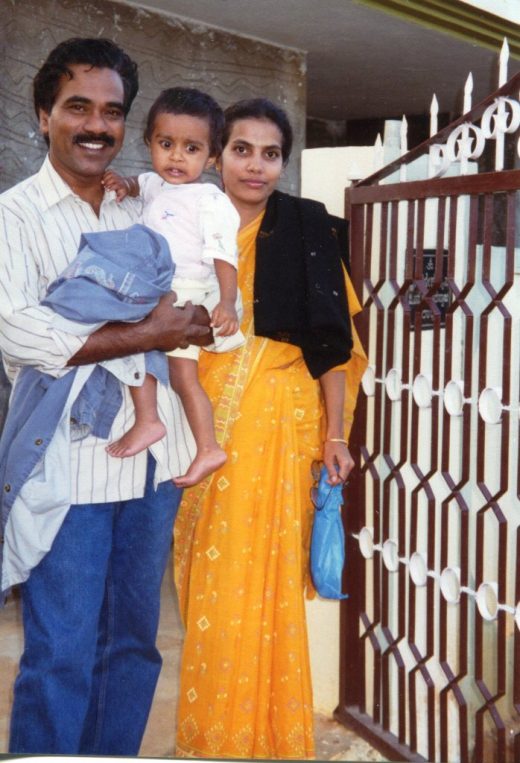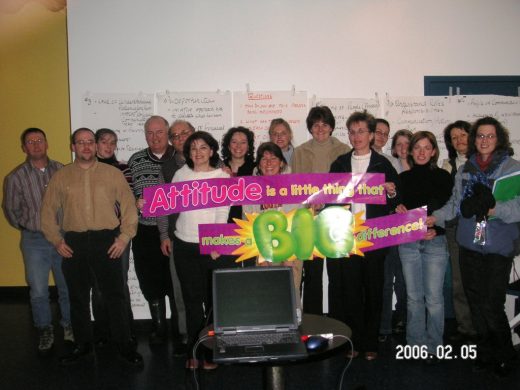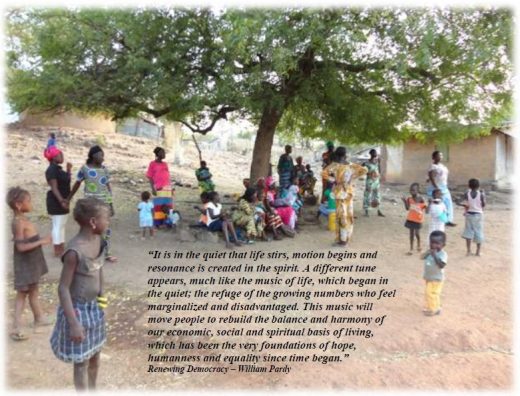
ACKNOWLEDGEMENTS
This study tour was made possible with the support and assistance of many. First and foremost, Sam Chelladurai and his family who provided accommodation, guidance and a varied itinerary. The Commonwealth Foundation who provided support for travel costs. Numerous development groups, local community associations and individuals who shared their work, knowledge and hospitality. To all who contributed to this insightful and fascinating tour I am truly grateful.
INTRODUCTION
Attendance at the 1996 COMMACT Conference
The Commonwealth Association for Local Action and Economic Development (COMMACT) Conference held in October 1996 in Northern Ireland afforded me exposure to innovative development methodologies happening in India. I was most impressed by an approach in India called PRA Mapping or Participatory Resource Analysis through the use of Village Maps. In particular, Sam Chelladurai’s slide presentation depicting the process was inspiring. I had utilised mapping techniques and Geographical Mapping Technology in some of my own work and was most interested to learn more about such processes. A personal camaraderie also developed with Sam, which led to an offer to visit India and share our experiences. This proposition was complemented by his offer to accommodate me and arrange a suitable itinerary. The decision to make the journey was solidified with confirmation of support to augment my travel costs by the Commonwealth Foundation in London.
OBJECTIVES
The objective of this visit was twofold. This was an opportunity for me to visit development projects and explore participatory processes being utilised in village/community development in India. Of particular focus, was process techniques in mapping, micro finance and community training. The visit also provided an opportunity for me to share with development organisations my own experience in community development in both Britain and Canada. My own work which had utilised Geographic Information Systems in community analysis and video and television technology in community education were of pertinent interest to all whom I met.
OVERVIEW OF VISITS
This study tour provided opportunities for me to visit, tour and share experiences with numerous development groups in both the Northern and Southern regions of India.

These organisations were involved in a variety of activities as can be seen from the following outline:
| 1. | CHURCH OF NORTH INDIA – Synodical Board of Social Services – New DelhiContact: Mr. Cherian Matthews – Programme Director.This organisation is a Protestant based development organisation supported by a variety of funders. They work in rural villages in the North and East of India providing motivational and animating support. They utilise a mapping process primarily as a way to have people explore their village history and to understand their current circumstance. This organisation has also begun experimenting with various approaches to micro banking. They have in excess of 200 trained workers involved in their village work. |
| 2. | PIDT – People’s Institute for Development and Training – New DelhiContact: Dr. Subachari DasGupta.This non-governmental development organisation works in urban environments, rural settings and with tribal groups. They are supported by a variety of funders. Dr. Dasgupta is joined in his work by his wife and a son and daughter, both of whom have planning backgrounds.One focus of their activities is in primary school education with some 700 teachers working in small villages. PIDT has multifaceted endeavours that extend from research and documentation through to developmental and educational activities. They were most interested in mapping techniques and technologies, as mapping and PRA are integral to their own work. Geographic Information Systems (GIS), they felt might enhance their own initiatives.
|
3. |
PRAXIS – An Institute for Research Education and Development – BangaloreContact: Mr. Alex TuscanoThis non-governmental development organisation was established in 1980. Mr. Tuscano explained that development on the 80’s mostly focused on economic expansion with little recognition of social implications or need. This focus led Praxis into its role of working for social justice through greater self reliance among people.They work in support of 150 villages with a focus on fishery decline, local credit, income and employment stability, women’s leadership and health issues and children’s supplementary education. They provide a novel information dissemination service to their rural villages supplying among other things, regular newspaper clippings of issues pertinent to each village.
|
| 4. | BCO – Bangalore Consultancy Office – BangaloreContact: Mr. M K Bhat – Principal ConsultantThis organisation performs various research and consultation work for development groups, non-governmental organisations and donor agencies. It consists of a team of five people augmented by twenty contract consultants. They are a member of the Donor Agency Network in India. Primary funding for their activities comes from NOVIB a Dutch Donor Organisation based in the Hague. |
| 5. | CED – Centre for Education Documentation – BangaloreContact: Mr. John D’Soueze, DirectorThis non-governmental organisation has taken on a remit to enhance the effectiveness of grass roots groups through the provision of adequate and timely information. In addition to their facilities in Bangalore they have a centre in Bombay. Their focus is on research, information and resource dissemination to whoever has such needs. Much of the service provided is free but, they do charge for some of their activities. One significant service is the provision of news clippings on a variety of development issues. |
| 6. | SOCO – Society for Community Organisation Trust – MaduraiContact: Mr. A Mahaboob Batch – DirectoThis non-governmental organisation was established in 1982 with the support and encouragement of a number of retired Indian Judges. Their primary focus is on human rights and creating among local villages an awareness of individual basic rights. Their facilities include a legal and training centre and current activities include promotion, lobbying, and advocacy campaigns on all matters legal pertaining to NGOs, the public, students, women and children. They have a particular focus on the plight of child and bonded labour. Street theatre and video programs are two of the tools utilised in their efforts. This organisation employs 33 people whose duties are varied and include such things as documentation and translation. |
| 7. | DESAM – Development Solidarity Action Movement – MaduraiContact: Mr. Abdul Bhai – PresidentThis organisation comprises some 40 NGO’s and local development groups. Its purpose is to strengthen small NGO’s in rural and urban areas through enhanced information flows and networking. They have set out to upgrade and enhance the professional skills of development workers and NGO staff and encourage the mobilisation of more local and financial resources. |
| 8. | PACE TRUST – MaduraiContact: Mrs. Meena Umapathy – DirectorThis NGO works in 25 rural villages and focuses on women’s development particularly, entrepreneurship. They receive both government and foreign donor support in their programmes which leans heavily towards micro lending and community banking as tools to effect economic transformation. A tour was provided to a rural village where the very poor have been provided two cows each through a local investment programme with the milk sold to a similarly funded local dairy. Local incomes have been considerably enhanced as a result. |
| 9. | LAND – Land Network Development Association – MaduraiContact: Mr. SPS Babu – DirectorA registered NGO which started in 1989, it sustains itself through government programmes and local financial support. The organisation’s primary focus is on marginalised landless people, land acquisition and dispersal and irrigation development of wasteland. They work to attain land from large landowners and utilise university students to assist in research efforts to create natural and sustainable farming techniques. They make use of micro credit programmes, youth education and plan to make use of local radio and television as tools for development. LAND has a staff of 9, 5 of whom are women, and are involved in 40 villages.Mr. Babu brought me to two villages to view first hand – water recycling, micro credit approaches, and water tank rehabilitation, all of which are carried out by women’s groups.
|
| 10. | INSTITUTE FOR SOCIAL AND ECONOMIC CHANGE – BangaloreContact: Dr. Rajase KharThis research institute is affiliated with Bangalore University. They are an autonomous quasi-government organisation receiving 80% of their funding from the Indian Government. They are primarily involved in research and analysis but do some teaching for post graduate students in socio/economics and agriculture. They also have sophisticated library and resource materials which are readily available. This institute was the primary research organisation utilised by the Indian Government in developing its current Structural Adjustment Policy formed on globalisation and free markets. |
| 11. | CARMELJYOTI SEMINARY – BangaloreContact: Father Robert Thomas PudusseryThis facility is a training organisation for Christian Brothers and Priests which is sponsored by the Catholic Church of Germany. They have accommodation for 40 people and are striving to become a self sustaining institution. They provide outreach services to neighbouring villages and communities but provide little in the way or social support because of their numbers and the heavy study schedules of the participants. |
| 12. | G R D E S – Gudibanda Rural Development and Education Society – GudibandaContact: Mr. M S NagarajaThis NGO was founded in 1982 to address rural poverty and its results. Utilising foreign funding they provide a series of programmes such as water preservation, forestation, community analysis and mapping, women’s development, education, youth programs and medical support. They have an innovative approach to literacy training building upon local language and common words whereby they create awareness of many issues, in particular those pertaining to health and hygiene. I was invited to attend a medical camp at their complex and witnessed a husband and wife medical team treat 200 plus people on a Sunday afternoon. |
| 13. | GRAMA – ChallakereContacts: Mr. C.M. Ramish and Mr. Satyashankar AithalThis organisation was founded in 1989 by Mrs. Grijama Rudhriah, a social worker, and incorporated in 1991 as a NGO with a 9 member trust board. They have 25 staff working in 180 villages in a novel setup of 6 substructures called Hoblis, each with a manager. Each Hobli has as many as 40 villages. They are primarily funded by NOVIB the Dutch funding agency. The primary focus of this organisation appears to be creating greater self reliance at the village level through savings and loans programmes and income generation facilitated by self help groups who have at their locus gender sensitivity.Each self help group is structured with a local animateur and is overseen by another regional animateur representing 10 villages. Future plans include an approach to consolidate the total financial capacity of all through a cluster concept comprising 20-25 groups. This they hope will assist in influencing the banking system to recognise the potential of such areas. I was fortunate to visit three villages and meet and discuss with several of these women’s groups their activities and approaches, not only to financial and entrepreneurial development, but overall community enhancements.
|
| 14. | REDS – Rural Education Development Society – TumkurContacts: Ms Joythiraj and Mr. M C Raj – DirectorsThis non-governmental organisation was started in 1984 and has as its primary focus work with the Dalits (outcasts). Organised around people’s committees it has developed an approach to education based on Participatory Training Methodology (PTM). REDS is developing itself as a resource centre for holistic development providing necessary educational and organisational support to the Dalit movement.I was fortunate to participate in a two day workshop hosted by REDS entitled “Towards the Dalit Liberation”, where I had opportunity to meet a large number of people committed to development work with the poor and oppressed. Each had their own thoughts, techniques and approaches to such development activities. There was common agreement that changing what exists, is neither easy, short term or without great effort. |
OBSERVATIONS AND REFLECTIONS
- NGOs in India are facing similar issues as development groups in developed countries. They are being requested to be more self reliant, endure funding cuts and to market themselves. The conundrum inherent in this philosophy is the clash of socio-economic activism beliefs and consideration of a marketplace concept. The main dilemma ensuing is how do the poor and marginalised pay for such services.
- There are 30,000 registered NGOs in India. The diversity of activities has to be enormous.
- All my hosts – the development groups were super caring, very warm and most generous. I was made to feel very much part of their efforts, invited to participate, challenged to discuss relevant issues and provided hospitality second to none.
- There was tremendous dedication – most groups that I met worked every day, seven days a week and lived within their organisational structures or in close proximity. Development work, for them, is a mission not really a job.
- There was an amazing spectre of life and energy, in the midst of decay, litter, and every imaginable and unimaginable type shelter. Despite such hardship, you can see an vitality and industry that’s inspiring. At six in the morning or at ten at night people are cooking, cleaning, performing physical labour and getting on with their lives, apparently oblivious to the poor condition of their surroundings.
- The contrasts were as insightful as the similarities. For instance it becomes obvious that “development” is about change – shifting people from conventional to necessary. The challenge is to get people to recognise a changed environment (i.e., technological advances which have automatically moved them from familiar lifestyles). Any development (new influence) subsequently implies cultural change.
- A question arises – is entrepreneurial activity beneficial if it doesn’t transform peoples lives? How do we weigh the cost inherent in any transformation? One group was encouraged to use a local micro credit system to purchase two cows. This enhanced their economy (individually and collectively) considerably. From where then does the empathy emanate to ensure an improved social environment? For instance, if the milk becomes the only measure of wealth, will children be deprived of their share in order for the family wealth to be expanded? Subsequently, will such expanded wealth lead to poorer nutrition? These are all issues similar to those with which we, in the developed world, struggle due to advanced technology and fiscal reforms (i.e. we have expanded wealth yet there is higher unemployment thus less participation in the economy.)
- Interventions by NGOs need to be analysed and debated in order to ensure positive outcomes. I raised questions, such as, will micro lending lead to a debt mentality making people more reliant on outsiders? People currently are involved in new processes and programs yet aren’t made aware of the whole picture or from where NGO funds emanate. What happens as these outside sources of funds retreats.
- The historical context of people’s progress is a critical issue. Having people explore their circumstances and review the changes they have experienced can be a valuable process for awareness, education and subsequently development. The use of mapping techniques can facilitate this awareness.
- I would suggest from my exposure here and work elsewhere that women appear the catalyst to change in all societies. One speaker suggested that if you educate women, then the whole family are educated. Such generalisations presupposes some remnants of a family structure.
- Much of our experience in attempts at regeneration in marginalised areas of Canada and Britain could provide valuable insights for those involved in development in India. It may assist them to not fall into similar traps as we have done (i.e. dependency culture, development at a high social/cultural cost and the creation of more unsustainable structures).
CONCLUSIONS
The visits, dialogue and the warmth that was shared, affirmed much of what I have come to value in the work of community building. It has been my contention that a process to recreate a context of community is fundamental to economic and social regeneration and rejuvenation. Such a people process must engage people with friends, family, outsiders and fundamentally with themselves. It is long term and requires dedicated committed people to facilitate and novel ideas and concepts to bring awareness that indeed the world has changed dramatically and forever yet, life has not changed – only the way we live it. An area such as India, with its strong family and community commitments provides fertile material to share in our communities as they address their own community rebuilding schemes.
My discussions and tours afforded me new ideas. Hopefully, it provided my new found colleagues new thoughts, new tools and some challenge to their own approaches, many of which, mirror things that have long ago been abandoned or changed in our approaches to community, social and economic development.
The opportunity to expand my horizons and beliefs has encouraged me to follow through with many of my Indian colleagues an exchange of information, contacts and hopefully projects that might be beneficial to us both. One of my future aims is to develop an exchange methodology, maybe initially through the use of video conferencing technology, allowing opportunities for grassroots exchange – people sharing with people. Fundamentally, it is my belief that this could be the most effective way to encourage, create awareness and reveal new opportunities to people.
Words barely describe such an experience much as pictures rarely portray what one sees. What one feels after such an opportunity is even more difficult to relay. Having completed other similar study tours, I have come to realise that each are trips of a lifetime, only because, of the many wonderful and warm people that I have been so blessed in meeting along the way. Each one has affirmed my faith in life, in living and the real and true humanness of people.

